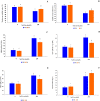Arbuscular mycorrhizal symbiosis regulates the physiological responses, ion distribution and relevant gene expression to trigger salt stress tolerance in pistachio
- PMID: 34539115
- PMCID: PMC8405761
- DOI: 10.1007/s12298-021-01043-w
Arbuscular mycorrhizal symbiosis regulates the physiological responses, ion distribution and relevant gene expression to trigger salt stress tolerance in pistachio
Abstract
Mycorrhizal symbiosis is generally considered effective in ameliorating plant tolerance to abiotic stress by altering gene expression, and evaluation of genes involved in ion homeostasis and nutrient uptake. This study aimed to use arbuscular mycorrhizal fungus (AMF) to alleviate salinity stress and analyse relevant gene expression in pistachio plants under No/NaCl stress in greenhouse conditions. Arbuscular mycorrhizal symbiosis was used to study the physiological responses, ion distribution and relevant gene expression in pistachio plants under salinity stress. After four months of symbiosis, mycorrhizal root colonization showed a significant reduction in all tested parameters under salt stress treatment compared to non-saline treatment. Salinity affected the morphological traits, and decreased the nutrient content including N, P, Mg and Fe as well as K/Na and Ca/Na ratios, relative water content (RWC), membrane stability index (MSI), and increased the concentration of K, Ca and Na nutrient, glycine betaine, ROS and MDA. Inoculation of seedlings with AMF mitigated the negative effects of salinity on plant growth as indicated by increasing the root colonization, morphological traits, glycine betaine, RWC and MSI. Specifically, under salinity stress, shoot and root dry weight, P and Fe nutrient content, K/Na and Ca/Na ratio of AMF plants were increased by 53.2, 48.6, 71.6, 60.2, 87.5, and 80.1% respectively, in contrast to those of the NMF plants. The contents of Na, O2•- and MDA in AMF plants were significantly decreased by 66.8, 36.8, and 23.1%, respectively at 250 mM NaCl. Moreover, salinity markedly increased SOS1, CCX2 and SKOR genes expression and the inoculation with AMF modulated these genes expression; however, NRT2.4, PHO1 and PIP2.4 gene expressions were increased by salinity and AMF. It could be concluded that inoculation of AMF with Rhizophagus irregularis conferred a larger endurance towards soil salinity in pistachio plants and stimulate the nutrient uptake and ionic homeostasis maintenance, superior RWC and osmoprotection, toxic ion partitioning, maintaining membrane integrity and the ion-relevant genes expression.
Keywords: Arbuscular mycorrhizal fungus; Ion-related genes; Mineral nutrient; NaCl; Pistacia vera; Reactive oxygen species (ROS).
© Prof. H.S. Srivastava Foundation for Science and Society 2021.
Conflict of interest statement
Conflicts of interestThe authors declare that they have no conflict of interest.
Figures


References
-
- Abbaspour H. Investigation of the effects of vesicular arbuscular mycorrhiza on mineral nutrition and growth of Carthamus tinctorius under salt stress conditions. Russian J Plant Physiol. 2010;57:526–531. doi: 10.1134/S1021443710040102. - DOI
-
- Abbaspour H. Contributions of arbuscular mycorrhizal fungi to growth, biomass and nutrient status of pistachio seedlings under saline conditions. J Nuts. 2016;7(1):67–74.
-
- Abd-Allah EF, Hashem A, Alqarawi AA, Bahkali AH, Alwhibi MS. Enhancing growth performance and systemic acquired resistance of medicinal plant Sesbania sesban (L.) Merr using arbuscular mycorrhizal fungi under salt stress. Saudi J Biol Sci. 2015;22:274–283. doi: 10.1016/j.sjbs.2015.03.004. - DOI - PMC - PubMed
-
- Abdel-Fattah GM, Asrar AWA. Arbuscular mycorrhizal fungal application to improve growth and tolerance of wheat (Triticum aestivum L.) plants grown in saline soil. Acta Physiol Plant. 2012;34:267–277. doi: 10.1007/s11738-011-0825-6. - DOI
LinkOut - more resources
Full Text Sources
Miscellaneous
